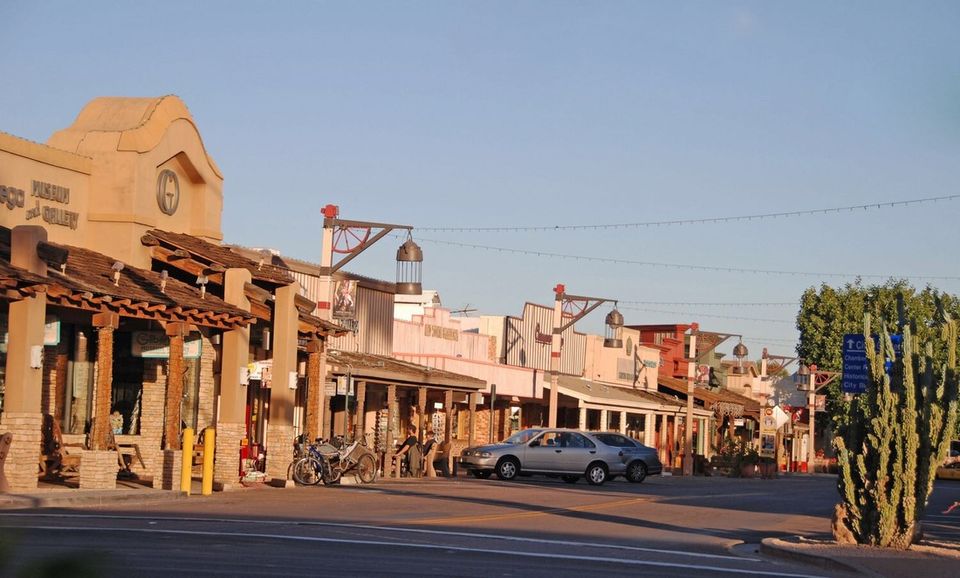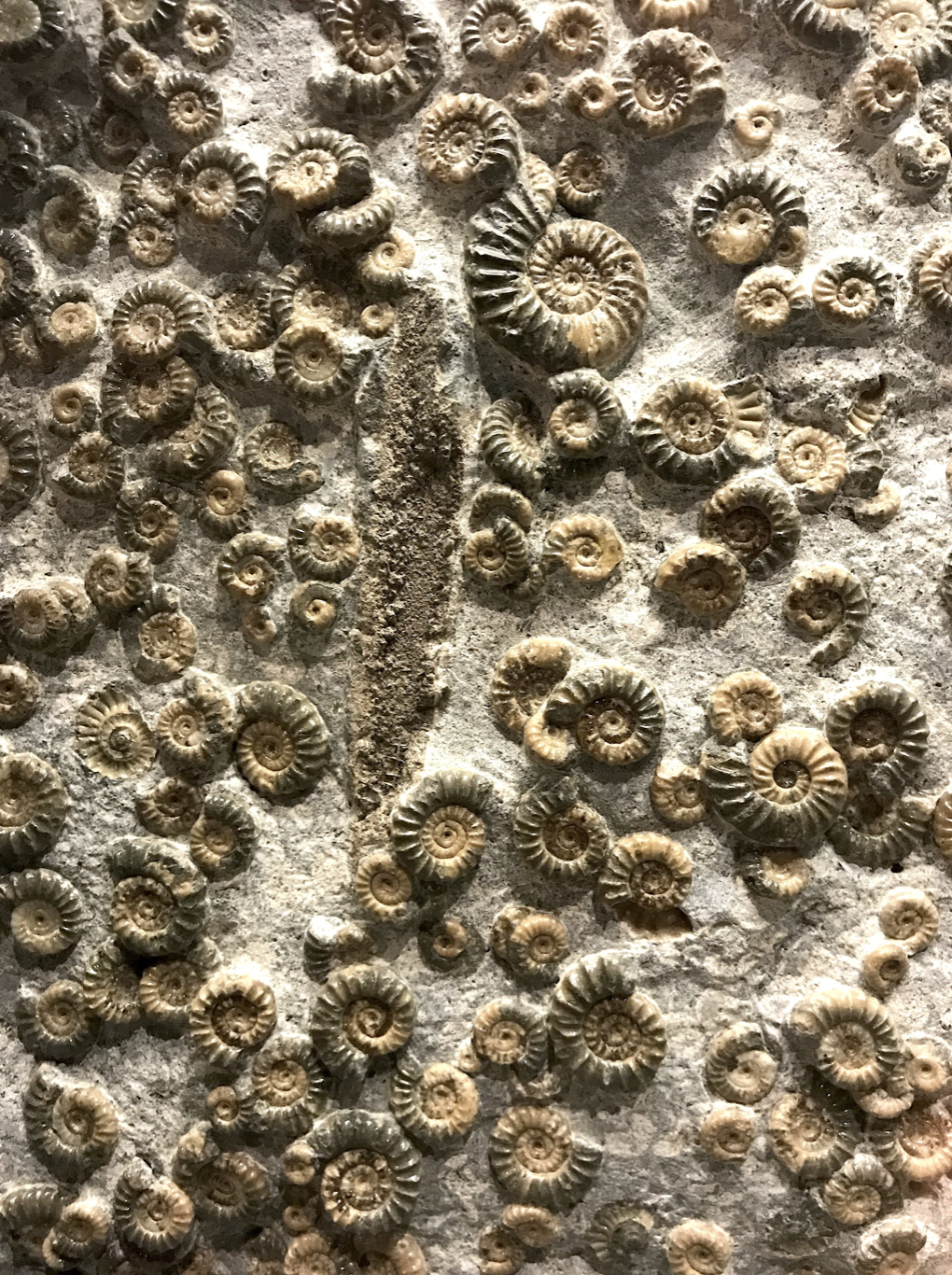A writer walks through a suburb of a desert city. He finds that art, souvenirs, tradition, memory, and dam-building and citrus trees have something to do with each other. This is the first of five essays.
I left at dusk. My bag was packed with a few cigarillos, a small notebook, and my denim jacket. It was finally cool in the evenings. I had once before walked parts of downtown Scottsdale, a northeastern suburb of Phoenix, AZ. But I had been sick, and it was distractingly hot then. Tonight I had the whole evening if I wanted it, work the next morning notwithstanding.
There are a few districts to Old Downtown, est. 1894, named after an Army Chaplain, Winfield Scott. First is the Art district, less than a third of a New York City avenue block. Scottsdale Blvd runs north/south; Main St. runs east/west, cutting Scottsdale into quadrants. The art district lay mostly on Main St. on the west side of Scottsdale Blvd.
By the evening’s end I had written down fifty-eight individual art galleries on Main St. alone. There are over one hundred. These galleries were like brownstones in Williamsburg, Brooklyn, representing about as many unique characters. At Esse Objects de Art everything was made of the same material: a fade-gold metallic. If it had a smell, it would be whatever golden mold smells like. On a victorian table sat a sci-fi motorcycle, all luscious curves, a massive wheel on the back, low handlebars, and a woman clad in nothing, exaggerating herself on the seat. Further down were the Shorr Gallery, Romanov Fine Jewelry, and Gallery Russia, which displayed a 6’x8’ canvas titled, In the South, by Renat Ramazanov.
Why this boon of art?
Scottsdale is next to Los Angeles and New York in art sales, and while it is the wealthiest part of AZ, that can’t be a sufficient enough reason. While the prospect of money is a reason to paint, it’s not a reason for painting any particular painting. Commissions bought Michelangelo’s marble, it didn’t inspire David.
Let the wealthy desire all the status, sophistication, and expression art can give, and you’ll have indiscriminate buyers. But here there were genres, styles, communities of artists and galleries, some of which weren’t getting enough interest to justify their remaining. Emerging from half-complete sculptures were ravenous, desirous feminine shapes. There were the self-titled Southwestern artists whose work caught the burning orange, pristinely wild, leathery understanding of the west, all triggers for a memory that no one looking at them could have had personally—all of Proust’s madeleine without the narrator’s recollection.
One artist had labeled their art as, “art that embraces awareness”. I never had to ask the question, “what’s it trying to say?” The art was straightforward. Each painting was given in hand to be received and enjoyed. It was, and perhaps the context of the town helped, perfectly apparent what the meaning of the art was. Artistic style did not vary the message. The abstract was knowably abstract, the impressionistic was knowably impressionistic. This was art of near-perfect disclosure. You have to taste the fruit to know, but there was no need for analysis, no reason for study. It was all of it memory, established.
Here in Scottsdale, between art and the viewer, there was still the moment when the viewer (granted a very wealthy viewer) saw something desirable for and in itself.
One gallery gave art classes. As I passed by, twenty or so adults listened to an indefinite classical-piano piece were told how to get orange from a red/yellow mix. In front of them, at about the same stage of completion as theirs, was an impressionist canvas of some clouds or fire mixed together, which the teacher was painting. In front of all of them was the finished canvas they were replicating. Stacks of previous canvases laid behind them.
…
It’s difficult to know when to continue performing something. In February 2014, New York, on a rainy evening—when the snow was undecidedly melting then turning back into ice, then returning back to slush—I went to see the Britten Opera, Billy Budd, at the Brooklyn Art Museum (BAM). The London Philharmonic played the score. The Glyndebourne cast took the stage. They had returned to this opera, last played in 2010.
One of the few written in English, Billy Budd has more human (as opposed to stultifyingly social) moments than most operas. The purest of souls (Billy Budd) is unjustly punished for justly killing a man. At the penultimate moment, as Melville’s short story puts it, Billy Budd shouts out the words “God Bless Starry Vere!” This shocks the crew, and it shocked the audience at the BAM theater. Jacques Imbrailo who played Billy, as the noose fell on his neck, tensed his veins with the vibrato. He sung those words with desperation, with the sudden, bursting syllables –“God bless you!”–that the viewer cannot believe (one expected “Farewell!” or “Down with the tyrant!” or “Freedom!”).
The opera begins and ends with Captain Vere. He opens the story with a monologue addressed to the audience, “I am an old man,” and concludes the opera on the same dark stage. Lit at his sides so to provide the illusion of floating—like his own luminescent, flickering memory—he recalls that fateful year full of mutiny and fated angels. Delivering the last lines, he says, “I, Farfaix Vere, commanded the Indomitable,” and after a good silence, roaring applause. That’s how the iTunes soundtrack ends.
That night, however, the actors and the London Philharmonic would put a close to a performing tour in New York and would return to the UK. This was their last performance, and in it a moment not found in the iTunes version of the opera. It ended with John Ainsley, who played Vere, delivering the lines, “I, Fairfax Vere, commanded the Indomitable.” The lights went out. The audience applauded.
But in the moment before the lights went out, he drew breath, as if to go on. There were no more lines to speak. But there was one more in his mind. He let out that half sound of someone who wants to say more–but thinks better of it at the last second – a perfect aposiopesis, a stutter. The audience, who before this had remained silent, attentive, let out a small whimper—the exclamatory “oh” of a mother who’d seen a child fall and scratch their knee outside the window. We all wanted to know what he would have said. But it would remain unspoken.
The performance, and with them the performances, were ended. It could not be done again. Only recordings remained, which one could play over and over. On iTunes, all one buys is a recording of an event which was itself a repeated performance. No one plays that violin again, no tenor sings that note again. And it seems that at some point a performance becomes a recording, not a contribution to the work of art. Something about one piece of art refuses to pass itself on with reoccurrences. The store of meaning is exhausted. Still the song plays on.
…
The art class back in Scottsdale was called “A Splash of Merlot.” They splashed paint onto their canvases with a canvas of Pollock’s to inspire and guide them, but without the hesitation and anxiety that Pollock suffered over. The point that night was to paint. There was not a question of whether or not. There was no time to stop painting. Pigment was mixed. Brushes were dipped. Canvases were dabbed.
They work with the strokes, hues, and medium of Cezzane, perhaps one of his still-lifes, but without taking the hours it took him to add one stroke to the canvas. Has the art troubled them? Has the work taken them to mental and physical extremes? And what about the 20 canvases afterword? When they had dried, where do they go?
The painting isn’t deepened by being reproduced. A sentence is recited long after it’s lost its breath. A statue is chipped at after it is complete. At some point, what was craft becomes erosion.
…
There was in one of hundreds of Scottsdale art galleries, Bishop Gallery for Arts and Antiques, piles to the ceiling of furniture and Catholico-esque shrines. Much of it was made of wood and plaster. There was very little metal, very little shine. Near the door stood a statuette, about four feet tall. It was made of wood, and a little cracking on the top: two men, naked; one had wings folded up on his back. Their posture was as though at the beginning of a professional grappling contest, hands on shoulders, both bowing their heads together in the seriousness of “let us pray.” They weren’t proportional. They had thick limbs and small hairless heads. Their posture said men; their size said children. There was no label, no price tag. Was it a scene from Jacob’s wrestling with the Angel? It appeared to be. If it was the angel’ hand should be touching the man’s hip, but instead the man’s hand was extended to the angel’s waist. There was, as good sculpture can do, the sense of frozen motion, not just the absence of it. The two men were waiting for the wood to give way. They were drawn toward each other with locked grips, and skin slippery with sweat, whether to wrestle or to embrace. The sadness of their expressions together kept the possibility of their coming together for reconciliation. The statuette’s form hesitated precisely before being violent or resolved. I couldn’t wait to see which the men would give in to.




